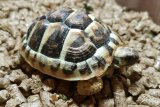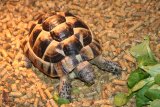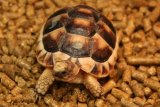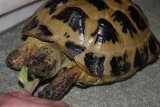




Several species of tortoise from the hot countries surrounding the Mediterranean are kept as pets, of which the Hermann's tortoise, the Mediterranean spur-thighed tortoise, and the marginated tortoise are the most popular, with the Egyptian/Kleinmann's and Negev/Werner's tortoise being far less common. If the tortoise does not have any accompanying legal paperwork (which should identify the species), the country of origin may give a hint as to which species is likely. However, tortoises obtained in any country may have actually naturally originated elsewhere, and therefore the country is not normally useful as a species indicator unless the tortoise is known to have been wild caught in that country (which would normally make it an illegal animal for all except the Horsfield's tortoise). For all of these species, if the tortoise was legally imported into the UK, the species should have already been conclusively identified by the importer and customs agents, since they are all legally protected by CITES even if the species does not require a certificate for subsequent sale.
In the absence of legal paperwork, these species can all be misidentified as each other for various reasons, and sellers may not identify which tortoise they have sold, particularly with older tortoises. It is best to get a specialist to help. It is normally possible to identify a species using the various features described below. However, identifying subspecies is normally done only based on markings, which can be completely unreliable. Therefore, identification of subspecies can normally be done only in cases where the origin of the animal or its ancestors are known for certain, or if the legal paperwork specifies it. Note that this guide relates only to the Mediterranean tortoises, not other species. It is possible for other tortoise species to be mis-sold as one of these tortoises, and a specialist would need to help with identification. (We have seen, for example, Sulcata tortoises which were sold as Horsfield's tortoises. This sort of mistake could have serious consequences if the new owner tried to house, feed or hibernate the tortoise as if it were the stated species.)
Note that it is also possible for hybrids to exist, and hybrids of marginated and spur-thighed tortoises are sometimes found as pets. These may have a blend of identification features from each species.
See further information about how to care for a Mediterranean tortoise.
| Feature | Hermann's | Spur-thighed | Marginated | Egyptian | Negev | Horsfield's |
|---|---|---|---|---|---|---|
| Thigh spur | No | One, sometimes with a second, smaller bump | No | No | No | Cluster of bumps |
| Arm scales | Big+small | Big+small | Big+small | Big+bigger | Big+bigger | Big+small |
| Hinged plastron | No | Mostly females | Mostly females | Mostly females | Mostly females | No |
| Indistinct young/male | Indistinct young/male | Less distinct young/male | Less distinct young/male | |||
| Supracaudal scute (over tail) | Divided | Single | Single | Divided | Divided | Single |
| Single | Single | Single | ||||
| Flared margin * | No | No | Adult males | No | No | No |
| Not young/female | ||||||
| Front claws | 5 | 5 | 5 | 5 | 5 | 4 |
| 4 | ||||||
| Back claws | 4 | 4 | 4 | 4 | 4 | 4 |
| 5 | ||||||
| Tail horn | Adults | No | No | No | No | Adults |
| Not young | Not young | |||||
| Nuchal scute | Present | Present | Present | Present | Present | Present |
| Absent | Absent | |||||
| Adult shape * | Oval | Oval | Long+domed | Oval | Oval | Round |
| Adult shell length * | Normally about 20 cm but sometimes 30 cm long | Anywhere from 15 cm to over 30 cm depending on subspecies and other factors | 25 to 35 cm | 8-10 cm | 8-10 cm | Normally about 20 cm |
| Common carapace marks † | Defined black marks (simetimes with a brown shadow) at the front triangle (lateral) or W (dorsal) of each scute, with a yellow background, sometimes fully black as adults | Poorly defined brown/black marks or sometimes well defined (Tunisian) black marks at the front edge (lateral) or W (dorsal) of each scute, with a light brown background, usually fully dark brown or black as adults, or yellow with a black blotch in the middle of each scute as golden adults, or matching Hermann's as Tunisian adults | Golden glowing mark at the rear of black scutes, with the golden parts remaining tiny on adults | Mostly yellow, sometimes with black outlines at the front of each scute, very rarely with larger dark markings matching marginated as adults | Mostly yellow, sometimes with black outlines at the front of each scute | Black blotch like splashed ink on each scute, fading to completely yellow or grubby black on most older adults |
| Common margin marks † | Black and yellow triangles or L-shaped marks | Black and yellow triangles or L-shaped marks, or sometimes fully yellow (golden) | Black and yellow triangles | Mostly yellow, sometimes faint black lines | Mostly yellow, sometimes faint black lines | Black and yellow blotches |
| Common plastron marks † | Defined blotchy or joined marks down most/all scutes, with a gap down the middle | Messy blotches on both sides, often with a central gap but not always, sometimes identical to Horsfield's | Triangles pointing rearwards, usually 4 on each side | Triangles pointing rearwards, one on each side, sometimes with tiny versions in front, or almost completely yellow | Often completely yellow, but may have faint marks or triangles pointing rearwards, one or two on each side | One blurry-edged blotch per scute with new growth yellow between scutes |
| Skin colour † | Dark head, light neck and chin, light upper arms, dark ouside of forearms, often light inside of forearms and hands, often light patches on darker areas | Dark or light head and arms, often slightly lighter neck and upper arms, often light patches on darker areas | Light on youngsters with darker tops of the head and forearms, darker areas turning much darker on adults, sometimes a light patch (cap) on top of the head | Mostly yellow, sometimes with a darker patch around the mouth or top of the head | Mostly yellow, sometimes with a darker patch around the mouth or top of the head | Dark head, light neck and chin, light upper arms, dark ouside of forearms, often light inside of forearms and hands, often light patches on darker areas |
* Shell shape and size is often completely unreliable, due to regional variations, poor care regimes, lack of natural/artificial sunlight, and individual variations. Age is normally guessed for wild-caught animals, so final size may not have been reached.
† Colours and markings can be completely unreliable, due to regional and subspecies variations, albinism, hypomelanistic genetic traits, and melanistic genetic traits. All of these species can turn black as adults. Markings may wear off on adults, changing their shape. Golden spur-thighed, hypomelanistic spur-thighed, hypomelanistic Hermann's, yellow Horsfield's, Negev and Egyptian tortoises can all look like each other. Dark Egyptian tortoises and lighter marginateds can look like spur-thighed. Tunisian spur-thighed can look like Hermann's. Spur-thighed can have plastron markings matching Hermann's or Horsfield's.